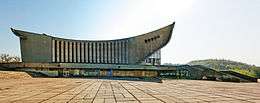Vilnius Palace of Concerts and Sports
| Sporto Rūmai | |
 | |
| Full name | Vilnius Palace of Concerts and Sports |
|---|---|
| Location | Vilnius, Lithuania |
| Coordinates | 54°41′27″N 25°17′28″E / 54.69083°N 25.29111°ECoordinates: 54°41′27″N 25°17′28″E / 54.69083°N 25.29111°E |
| Capacity | 4,400 |
| Opened | 1971 |
| Closed | 2004 |
Vilnius Palace of Concerts and Sports, also known as the Sporto Rūmai, is an arena in Vilnius, Lithuania. It is located on the site of the Piramónt cemetery, the oldest Jewish cemetery in Vilnius, which dates back to the late fifteenth century, when Vilnius was the capital of the Grand Duchy of Lithuania.[1] Russian authorities closed the cemetery in 1831. In 1935, the Vilna Board of Rabbis and the Vilna Gaon Synagogue in Tel Aviv protested the Polish municipal authorities' plans to construct a sports stadium there.[2]Soviet authorities destroyed the cemetery in 1949-1950 during the construction of Žalgiris Stadium. The Vilnius Palace of Concerts and Sports was opened in 1971. It was closed in 2004 and deeemd unsafe.
The arena was capable of holding 4,400 spectators. It was primarily used for volleyball and basketball. In October 1988, the arena was the site of the Inaugural Congress of Sąjūdis, the Reform movement which led Lithuania in achieving independence from the Soviet Union. It was also the site of the public funeral of 13 Lithuanians massacred by Soviet troops at the Vilnius television tower on January 13, 1991.
The arena is emblematic of Communist Modernism. It is one of the few remaining sports arenas in this architectural style. Two other examples are the Hala Olivia in Gdansk, Poland, and the now destroyed Volgar Sports Palace in Tolyatti, Russia.[3]
In August, 2015, Lithuania's Chief Rabbi Chaim Burshtein was dismissed by the Jewish Community of Lithuania after he made a public statement opposing the conversion of the arena into a convention center.[4] In 2016-2017, a petition opposing the convention center received 38,000 signatures, many from descendants of Lithuanian Jews now living in other countries.[5]
References
- ↑ Lithuania’s liveliest cemetery, 13 December 2015
- ↑ Document Unearthed: 1935 Tel Aviv Protest Against Plans to Defile the Old Vilna Jewish Cemetery, 14 June 2016
- ↑ Vilniaus koncertų ir sporto rūmų renovacijai reikės apie 100 mln. litų (in Lithuanian)
- ↑ Lithuania’s Chief Rabbi Fired Days After Public Statement on Old Jewish Cemetery, 14 August 2015
- ↑ Lithuania reconsiders plans to build atop former Jewish cemetery — report, 22 February 2017